交换机路由器基本命令
交换机路由器基本命令
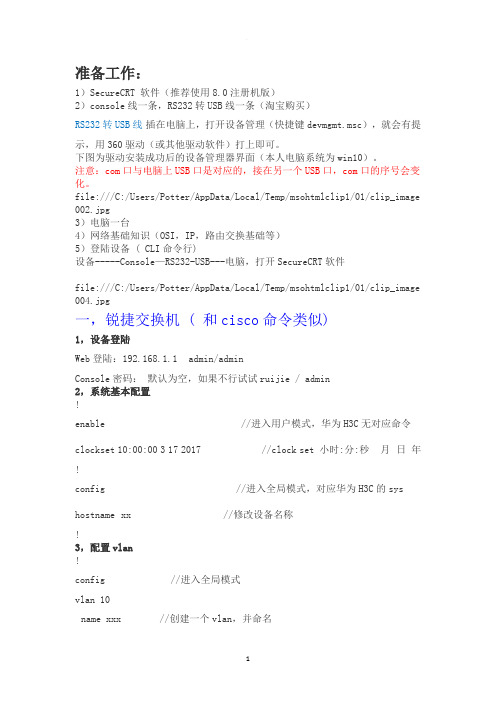
准备工作:1)SecureCRT 软件(推荐使用8.0注册机版)2)console线一条,RS232转USB线一条(淘宝购买)RS232转USB线插在电脑上,打开设备管理(快捷键devmgmt.msc),就会有提示,用360驱动(或其他驱动软件)打上即可。
下图为驱动安装成功后的设备管理器界面(本人电脑系统为win10)。
注意:com口与电脑上USB口是对应的,接在另一个USB口,com口的序号会变化。
file:///C:/Users/Potter/AppData/Local/Temp/msohtmlclip1/01/clip_image 002.jpg3)电脑一台4)网络基础知识(OSI,IP,路由交换基础等)5)登陆设备 ( CLI命令行)设备-----Console—RS232-USB---电脑,打开SecureCRT软件file:///C:/Users/Potter/AppData/Local/Temp/msohtmlclip1/01/clip_image 004.jpg一,锐捷交换机 ( 和cisco命令类似)1,设备登陆Web登陆:192.168.1.1admin/adminConsole密码:默认为空,如果不行试试ruijie / admin2,系统基本配置!enable //进入用户模式,华为H3C无对应命令clockset 10:00:00 3 17 2017//clock set 小时:分:秒月日年!config//进入全局模式,对应华为H3C的sys hostname xx //修改设备名称!3,配置vlan!config//进入全局模式vlan 10name xxx//创建一个vlan,并命名vlan 20name xxxexit!no vlan 10 //删除一个vlan!int range gi 0/2-4sw mo ac//配置多个接口为access模式sw ac vl 10//配置多个接口加入vlan10exit!int range gi 0/5-8sw mo tr//配置多个接口为trunk模式sw tr al vl al//配置trunk模式下,接口允许所有vlan(1-4094)通过sw tr na vl 20//配置多个接口为trunk,并指定native vlan为20sw tr al vl remove xx //配置trunk模式下,接口不允许哪些vlan不通过sw tr al vl add xx//配置trunk模式下,接口添加哪些vlan允许通过exit!!sh vlan//查看 vlan 信息,包括 vlan id、名称、状态、包括的接口!sh int gi 0/2 sw//查看接口 Gi 0/2 的 vlan 状态!4,配置接口!configint gi 0/1des xx //给接口配置描述ip add 1.1.1.1 255.255.255.0//路由口配置IP地址,交换口无法直接配置no sh!int vlan 10des xx//给SVI接口配置描述ip add 172.16.10.1 255.255.255.0//创建SVI接口,一般为作为网关或管理地址!注意:SVI接口状态跟是否创建vlan,以及是否存在加入该vlan的up状态的接口。
鸿鹄论坛华为交换机路由器常见命令

华为交换机、路由器常见命令路由器基本配置命令举例Quidwaysysname router_name 命名路由器或交换机Quidwaydelete 删除Flash ROM中的配置Quidwaysave 将配置写入Flash ROMQuidwayinterface serial 0 进入接口配置模式Quidwayquit 退出接口模式到系统视图Quidwayshutdown/undo shutdown 关闭/重启接口Quidwayip address ip_address subnet_mask 为接口配置IP地址和子网掩码Quidwaydisplay version 显示VRP版本号Quidwaydisplay current-configuration 显示系统运行配置信息Quidwaydisplay interfaces 显示接口配置信息Quidwaydisplay ip routing 显示路由表Quidwayping ip_address 测试网络连通性Quidwaytracert ip_address 测试数据包从主机到目的地所经过的网关Quidwaydebug all 打开所有调试信息Quidwayundo debug all 关闭所有调试信息Quidwayinfo-center enable 开启调试信息输出功能Quidwayinfo-center console dubugging 将调试信息输出到PCQuidwayinfo-center monitor dubugging 将调试信息输出到Telnet终端或哑终端交换机配置命令举例大括号{}中的选项为单选项,斜体字部分为参数值Quidwaysuper password password 修改特权模式口令Quidwaysysname switch_name 命名交换机或路Quidwayinterface ethernet 0/1 进入接口视图Quidwayquit 退出系统视图Quidway-Ethernet0/1duplex {half|full|auto} 配置接口双工工Quidway-Ethernet0/1speed {10|100|auto} 配置接口速率Quidway-Ethernet0/1flow-control 开启流控制Quidway-Ethernet0/1mdi {across|normal|auto} 配置MDI/MDIXQuidway-Ethernet0/1shutdown/undo shutdown 关闭/重启端口VLAN基本配置命令以Quidway S3026为例Quidwayvlan 3 创建并进入VLAN配置模式,缺省时系统将所有端口加入VLAN 1,这个端口既不能被创建也不能被删除;Quidwayundo vlan 3 删除一个VLANQuidway-vlan3port ethernet 0/1 to ethernet 0/4 给VLAN增加/删除以太网接口Quidway-Ethernet0/2port access vlan 3 将本接口加入到指定VLAN idQuidway-Ethernet0/2port link-type {access|trunk|hybrid} 设置端口工作方式,access缺省不支持帧的传送,而trunk支持用于Switch间互连,hybrid和trunk的区别在于trunk只允许缺省VLAN的报文发送时不打标签,而hybrid允许多个VLAN报文发送时不打标签;端口聚合配置命令Quidwaylink-aggregation ethernet 0/7 to ethernet 0/10 {ingress|both} 配置端口聚合Port_num1为端口聚合组的起始端口号,Port_num2为终止端口号ingress为接口入负荷分担方式,both为接口出负荷分担方式;STP基本配置命令Quidwaystp {enable|disable} 开启/关闭STP 功能,默认关闭,开启后所有端口都参与STP 计算;Quidway-Ethernet0/3stp disable 关闭指定接口上的STP功能,如某些网络不存在环路可以关闭STP;PPP配置命令Quidway-Serial0link-protocol ppp 封装PPP协议Quidway-Serial0ppp authentication-mode {pap|chap} 设置验证类型Quidwaylocal-user username password {simple|cipher} password 配置用户列表- PAP验证配置:主验证方Quidwaylocal-user username password {simple|cipher} password 配置用户列表Quidway-Serial0ppp authentication-mode pap被验证方Quidway-Serial0ppp pap local-user username password {simple|cipher} password- CHAP验证配置:主验证方Quidwaylocal-user username password {simple|cipher} password 配置被验证方用户列表Quidway-Serial0ppp chap host hostname 配置本地名称Quidway-Serial0ppp authentication-mode chap被验证方Quidwaylocal-user username password {simple|cipher} password 配置主验证方用户列表Quidway-Serial0ppp chap user username 配置本地名称MP配置命令Quidway-Serial0ppp mp 封装MP协议Quidwayppp mp user username bind virtual-template number 建立用户与虚拟模板的对应关系Quidwayinterface virtual-template number 配置虚拟接口模板Quidwayppp mp max-bind number 设置虚拟模板最大绑定数1-100帧中继配置命令Quidway-Serial0link-protocol fr {mfr|ietf|nonstandard} 封装帧中继协议:IETF、Cisco兼容Quidway-Serial0fr interface-type {dte|dce|nni} 配置帧中继接口类型,NNI为帧中继交换机之间的接口;若配为DCE或NNI,则须先使能fr switching;Quidway-Serial0fr lmi type {q933a|ansi|cisco-compatible} 配置LMI协议类型Quidway-Serial0fr dlci dlci_number 配置一条本地虚电路号Quidway-Serial0fr map {ip|ipx} protocol-address dlci dlci_number 建立本地DLCI到对端协议地址的映射Quidway-Serial0fr inarp ip|ipx dlci_number 配置Inverse ARP动态映射Quidwayinterface type 创建并进入子接口配置模式RIP协议配置命令Quidwaydisplay rip 显示RIP配置信息Quidwayrip 启动并进入RIP配置模式Quidway-ripnetwork {network_number|all} 在指定网络上使能RIPQuidway-rippeer ip_address 配置报文的定点传送Quidway-Ethernet0rip version {1|2 bcast|mcast} 指定RIP版本及传送方式Quidway-Serial0rip work 指定接口工作状态同rip input,rip outputQuidway-ripauto-summary 配置RIP-2路由聚合Quidway-Serial0rip authentication simple password 配置RIP-2明文认证密码Quidway-Serial0rip authentication md5 key-string string 配置RIP-2 MD5密文认证密码串Quidway-Serial0rip authentication md5 type {nonstandard-compatible|usual} 指定MD5类型Quidwaydebugging rip packet 打开RIP调试开关Quidwayinfo-center console 将调试信息输出到PC静态路由配置命令Quidwayip route ip_address subnet_mask {interface_name|gateway_address} preference preference_value reject|black_bone命令说明reject:任何去往该目的地的报文均被丢弃,通知源主机不可达;black_bone:任何去往该目的地的报文均被丢弃,不通知源主机;当只有下一跳的接口是PPP或HDLC接口才能写interface_name,如Serial0,否则只能写gateway_address下一跳地址;命令举例Quidwayip route 16 10.0.0.2Quidwayip routeQuidwayip route 16 Serial2Quidwayip route 配置缺省路由;OSPF配置命令Quidwayrouter id ip_address 配置Router IDQuidwayospf enable 启用OSPF协议Quidway-Serial0ospf enable area area_id 配置当前接口所属的OSPF区域。
交换机路由器配置命令

交换机和路由器配置命令(必须掌握)交换机设置登录密码全局:line console 0:Password 123:login设置用户到特权密码全局:en password 123:en secret 123:no en secret (删除密码)为交换机配IP全局:in vl 1:ip ad 192.168.1.1 255.255.255.0:no sh为交换机配网关全局:ip default-gateway 192.168.1.10恢复交换机出厂值特权:erase startup-config (清空):reload (重启)删除所有VLAN 全局:no vl 1 - 1005创建VLAN全局:vl 2 (用于真机):in vl 2:name test 2 (改名为test 2)特权:vl database (用于虚拟机和真机):vl 2 name test 2添加端口到VL 全局:in ra(多个) f0/1 – 10:sw ac vl 2从VL删除端口全局:in ra(多个)f0/1 – 10:no sw ac vl 2配置中继链路全局:in f0/1:sw mode trunk:no sh (激活端口)在trunk中添加、删除VL全局:in f0/1:sw tr allowed vl remove vl 2(删除) 全局:in f0/1:sw tr allowed vl add vl 2(添加)路由器以上命令是我认为学交换机和路由器必须要掌握的。
先就为大家收集这么多了,希望大家能好好学习。
当中可能会存在错误,如果大家发现请及时通知我。
谢谢~!SIT806——无敌精英班 班长留给路由器接口配IP全局:in f0/1:ip ad 192.168.2.2 255.255.255.0 :no sh配置单臂路由全局:in f0/0.1:encapsulation dot1q 1(VL1) :ip ad 192.168.1.1 255.255.255.0查看路由表特权:sh ip route关闭路由全局:no ip routing添加逻辑端口全局:int loopback 0配置默认路由全局:ip route 0.0.0.0 0.0.0.0 address(下一跳IP)配置静态路由 全局:ip route 192.168.1.0 255.255.255.0 192.168.2.1配置动态路由全局:router rip:network 172.25.0.0(所有直连网段)RIP V2的配置全局:router rip:version 2:no auto-summary (关闭汇总)设置远程管理全局:line vty 0 4(允许0到4,五个用户登录):login:pawwword 123全局:enable password 123。
路由与交换的配置命令

1、switch>:用户模式——能查看版本信息2、在用户模式下输入enable会进特权模式——它能保存、修改、删除这一系列的配置switch>enable→switch#:特权模式,下面有一些命令就在此命令下完成:①、删除vlan的文件配置:delete flash:vlan.dat②、删除vlan中的配置文件:erase startup-config③、查看vlan配置文件是否被删除及vlan的是否创建:show vlan④、重新启动交换机:reload⑤、查看当前交换机的配置:show running-config⑥、保存对交换机所配置的内容,即是保存在Nvram:copy running-configstartup-config⑦、检查Nvram的内容:show startup-config⑧、检查虚拟接口 vlan的特征:show interface vlan 1⑨、查看接口IP的属性:show ip interface vlan 1⑩、查看cisco的信息:show version⑪、查看交换机所用快速以太网接口的默认属性:show interface fastethernet 0/18⑫、查看闪存目录中的内容:show flash 或dir flash3、在特权模式下输入configure terninal后会进入全局模式,一切的配置必须在此模式中进行配置Switch#configure terninal→switchp(config)#:全局模式①、配置路由器设备的名字:switch(config)#hostname + 交换机的名字②、配置进入特权模式的密码,即使能密码:switch(config)#enable password +密码③、配置非明文密码:switch(config)#enable secret + 密码4、为交换机配置console口①、进入现成配置模式,即进入console口:switch(config)# line console 0②、设置密码(重新启动时需要此密码):switch(config-line)#password + 密码③、允许登录:switch(config-line)#login5、配置远程登录的密码:①、首先要配置使能密码②、允许让几个人登录:switch(config)#line vty 0 4(即允许五个登录)③、设置密码:switch(config-line)#password + 密码④、允许远程登录:switchp(config-line)#login6、在全局模式下的有关命令①对所有密码进行加密:switch(config)#service password-encryption②、不解析错误的命令:switch(config)#no ip domain-lookup7、创建vlan(2—1001,注vlan 1既不可以创建,也不可以删除)①、创建vlan :vlan + 要创建vlan的值②、给vlan取名:switch(config-vlan)#name + 名字(此步可以不要)③、把PC与交换机相连的端口添加到相应的vlan中:a、Switch(config)#interface + 端口b、Switch(config-if)#switchport access vlan + 相应vlan的值④、需要传递多个vlan信息就要打中继口,即trunka、switch(config)#interface + 交换机另一端口b、switch(config-if)#switchport mode trunk8、传统vlan 的通信(1)、router的配置①、为接口配置IP地址(该IP是相应vlan的PC网关)②、激活端口:no shutdown(2)、switch的配置①、创建vlan,将PC端口划入相应vlan②、将switch与router相连的端口划入相应的vlan(3) 、PC的配置:就是给PC配置IP,注PC的默认网关与router的IP相同,网关相同9、单臂路由实现vlan的通信(1)router配置①、添加子接口:interface f0/0.1(此处有多少个vlan就添加多少个子接口)②、将子接口封装到相应的vlan:encapsulation dot + 相应vlan的值③、将子接口配置IP:ip add +ip地址 + 子网掩码④、激活物理接口:no shutdown(2)、switch的配置①、创建 vlan,交PC的端口划入到相应vlan②、与router相连的端口打trunk(3)、配置PC的IP9、三层交换(1)、配置三层交换①、启用三层交换:(config)#ip routing②、创建vlan:(config)# vlan + 要创建vlan的值③、把相应的vlan配置IPa、指定一个vlan:(config)#interface vlan + vlan相应的值c、配置IP:(config-if)#ip add + ip + 子网掩码(2)、配置switch①、每个交换机创建vlan②、把端口划分到相应的vlan中③、打中继口(trunk)Show命令1、show version 这个命令可以查看IOS版本号,已启动时间,Flash中的IOS 的文件名,router里面共有什么端口,寄存器的值等等。
华为路由器交换机常用命令
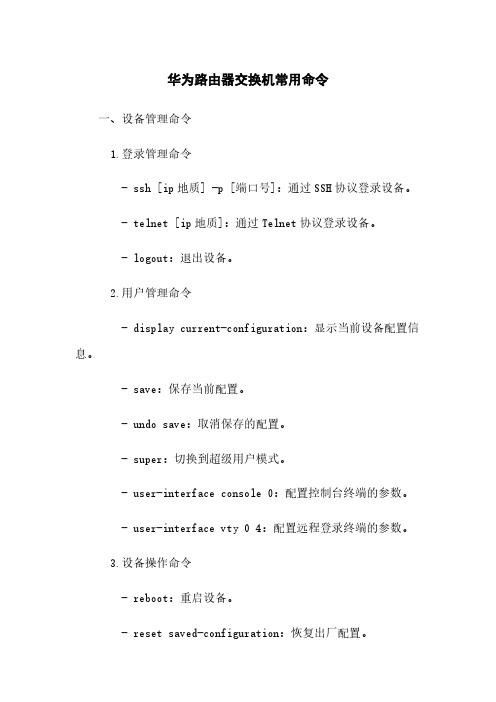
华为路由器交换机常用命令一、设备管理命令1.登录管理命令- ssh [ip地质] -p [端口号]:通过SSH协议登录设备。
- telnet [ip地质]:通过Telnet协议登录设备。
- logout:退出设备。
2.用户管理命令- display current-configuration:显示当前设备配置信息。
- save:保存当前配置。
- undo save:取消保存的配置。
- super:切换到超级用户模式。
- user-interface console 0:配置控制台终端的参数。
- user-interface vty 0 4:配置远程登录终端的参数。
3.设备操作命令- reboot:重启设备。
- reset saved-configuration:恢复出厂配置。
- display version:显示设备的硬件和软件版本信息。
- display device:显示设备的基本信息。
- display interface[接口名称]:显示指定接口信息。
- display ip routing-table:显示IP路由表信息。
二、网络配置命令1.IP配置命令- interface [接口名称]:进入指定接口。
- ip address [IP地质] [子网掩码]:配置接口IP地质。
- undo ip address:取消接口IP地质配置。
- ip route-static [目标网络] [子网掩码] [下一跳地质]:配置静态路由。
- undo ip route-static [目标网络] [子网掩码] [下一跳地质]:取消静态路由配置。
2.VLAN配置命令- vlan [VLAN ID]:创建指定VLAN。
- quit:退出VLAN配置模式。
- interface vlan [VLAN ID]:进入指定VLAN接口。
- ip address [IP地质] [子网掩码]:为VLAN接口配置IP地质。
交换机路由器基本命令大全
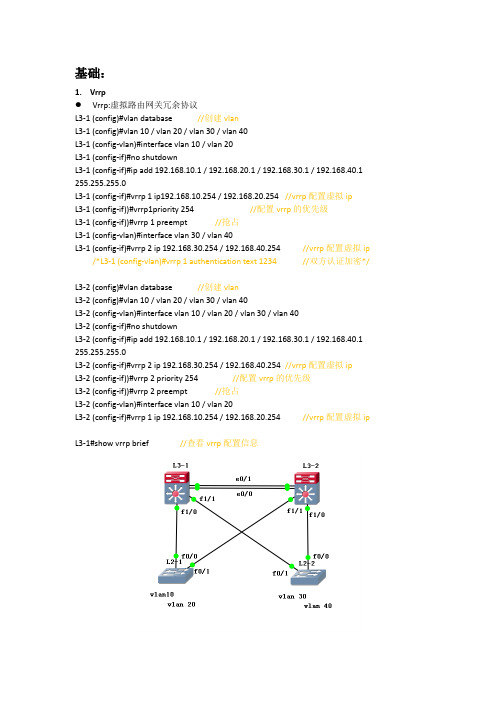
基础:1.VrrpVrrp:虚拟路由网关冗余协议L3-1 (config)#vlan database //创建vlanL3-1 (config)#vlan 10 / vlan 20 / vlan 30 / vlan 40L3-1 (config-vlan)#interface vlan 10 / vlan 20L3-1 (config-if)#no shutdownL3-1 (config-if)#ip add 192.168.10.1 / 192.168.20.1 / 192.168.30.1 / 192.168.40.1 255.255.255.0L3-1 (config-if)#vrrp 1 ip192.168.10.254 / 192.168.20.254 //vrrp配置虚拟ipL3-1 (config-if))#vrrp1priority 254 //配置vrrp的优先级L3-1 (config-if))#vrrp 1 preempt //抢占L3-1 (config-vlan)#interface vlan 30 / vlan 40L3-1 (config-if)#vrrp 2 ip 192.168.30.254 / 192.168.40.254 //vrrp配置虚拟ip /*L3-1 (config-vlan)#vrrp 1 authentication text 1234 //双方认证加密*/L3-2 (config)#vlan database //创建vlanL3-2 (config)#vlan 10 / vlan 20 / vlan 30 / vlan 40L3-2 (config-vlan)#interface vlan 10 / vlan 20 / vlan 30 / vlan 40L3-2 (config-if)#no shutdownL3-2 (config-if)#ip add 192.168.10.1 / 192.168.20.1 / 192.168.30.1 / 192.168.40.1 255.255.255.0L3-2 (config-if)#vrrp 2 ip 192.168.30.254 / 192.168.40.254 //vrrp配置虚拟ipL3-2 (config-if))#vrrp 2 priority 254 //配置vrrp的优先级L3-2 (config-if))#vrrp 2 preempt //抢占L3-2 (config-vlan)#interface vlan 10 / vlan 20L3-2 (config-if)#vrrp 1 ip 192.168.10.254 / 192.168.20.254 //vrrp配置虚拟ipL3-1#show vrrp brief //查看vrrp配置信息HsrpRouter (config)#interface fa0/1 ip 192.168.1.3 255.255.255.0 //进入端口配置ipRouter (config-if)#standby 2 //创建组Router (config-if)#standby 2 ip 192.168.1.254 //组添加ipRouter (config-if)#standby priority 200 //设置优先级,默认优先级100Router (config-if)#standby 2 preempt //抢占Router (config-if)#standby timers 3-10 //虚拟报文时间间隔Router (config-if)#standby 2 tranck fa0/0 //跟踪上行端口Router#show standby brief //查看热备份配置信息2.Mstp:多生成树协议Switch (config)#spanning-tree //启动生成树协议Switch (config)#spanning-tree mode mstp //设置生成树模式是mstpSwitch (config)#vlan 10Switch (config-vlan)#exitSwitch (config)#vlan 20Switch (config-vlan)#exitSwitch (config)#spanning-tree mst 1 priority 4096 //生成树组1的优先级设为4096 Switch (config)#spanning-tree mstconfigwration //进入生成树配置模式Switch (config)#instance 1 vlan 10,20 //把vlan10,20添加到组13.链路聚合L3-1 (config)#interface port-channel 1 //创建组L3-1 (config-if)#no shutdownL3-1(config-if)#switchport mode trunkL3-1(config-if)#interface fa1/13 //进入三层交换机间相连接口L3-1(config-if)#channel-group 1 mode on //添加到组中L3-1 (config-if)#switchport mode trunkL3-1 (config-if)#no shutdownL3-1 (config-if)#interface fa1/14L3-1 (config-if)#channel-group 1 mode onL3-1 (config-if)#switchport mode trunkL3-1 (config-if)#no shutdownL3-2(config)#interface port-channel 1 //创建组L3-2(config-if)#no shutdownL3-2(config-if)#switchport mode trunkL3-2(config-if)#interface fa1/13 //进入三层交换机间相连接口L3-2(config-if)#channel-group 1 mode on //添加到组中L3-2(config-if)#switchport mode trunkL3-2(config-if)#no shutdownL3-2(config-if)#interface fa1/14L3-2(config-if)#channel-group 1 mode onL3-2(config-if)#switchport mode trunkL3-2(config-if)#no shutdown4.VLAN(vtp)●Vtp(truch接口):Switch(config)#Vtpnamezjq //vtp命名zjqSwitch(config)#vtp password 123456 //设置vtp密码Switch(config)#vtp mode server(client) //vtp的模式设置为服务器或者客户端Switch(config)#interface FastEthernet0/1Switch(config)#switchport mode trunk //接口模式设置为trunk●配置vlanSwitch(config)#Vlan databaseSwitch(config)#Vlan 10 name xingzhengbuSwitch(config)#Switchport access vlan 10Switch(config)#Ip address 192.168.80.254 255.255.255.05.Tftp//打开tftp服务器,获取ip地址L2-1>enL2-1#copy startup-configtftp //Address of remote host []?172.16.25.0Destination filename [config.text]?zhangjq.txt6.telnet:远程登录Switch(config)#hostname silence //修改设备名称Switch(config)#intvlan 1Switch(config-if)#ip add 192.168.1.1 255.255.255.0 //设置管理交换机的IP地址Switch(config-if)#no shutdown //启用接口Switch(config)#enable secret 123456 //配置进入特权模式的密码为123456 Switch(config)#line vty 0 15//进入VTY端口,允许16台电脑同时远程登录Switch(config-line)#pass cisoco //设置Telnet的登录密码为ciscoSwitch(config-line)#login //允许Telnet登录7.管理VLAN扩展:1.路由引入(ospf)●静态路由配置(Static):要到达的网段Nwtwork:192.168.3.0/24设置下一跳Next Hop:192.168.1.2Router(config)#ip route 0.0.0.0 0.0.0.0 fa0/1●动态路由RIP:公布自己有的网段192.168.2.0/192.168.3.0OSPF:开放式最短路径协议Router(config)#router ospf 1 //启动OSPF协议,进程号Router(config)#network 192.168.1.0 0.0.0.255 area 0 //公布自己有的网段,划分区域Router(config)#do show iproute //查看路由表修改链路的开销1.Router(config-if)#bandwidth bamdwidth-kbps //修改接口的带宽参数2.Router(config-if)#ipospf cost “加数字”//命令则直接将链路开销设置为特定值并免除了计算过程2.DHCP的配置:动态主机配置协议L3-1(config)#vlan 10 //创建vlanL3-1(config-if)#intvlan 10L3-1(config-if)#ip add 192.168.10.1 255.255.255.0L3-1(config-if)#no shutdownL3-1 (config)#service dhcp //启动dhcpL3-1 (config)#ipdhcp pool <name> //建立地址池L3-1 (config)#network <network-number><mask> //动态分配ip的网段和MAC地址L3-1 (config)#default-router <ip-address> //为dhcp客户设置默认网关L2-1 (config)#interface fa0/0L2-1 (config-if)#sw mode trunkL2-1 (config-if)no shutdownL2-1 (config)#interface fa0/15L2-1 (config-if)#switchport mode accessL2-1 (config-if)#switchport access vlan 10 //绑定vlan 10L2-1 (config-if)no shutdownPC(config)#no ip routing //取消路由功能PC(config)#interface fa0/0PC(config-if)#ip add dhcpPC(config)#default gateway <ip-address>PC#show interface fa0/03.无线路由器AP>ap-mode fatAP>enAP#config tAP(config)#vlan 10AP(config-vlan)#exitAP(config)#service dhcpAP(config)#ipdhcp pool zhangjqAP(dhcp-config)#network 192.168.10.0 255.255.255.0AP(dhcp-config)#dns-server 10.20.5.1AP(dhcp-config)#default-router 192.168.10.254AP(dhcp-config)#interface gigabitEthernet0/1AP(config-if-GigabitEthernet 0/1)#encapsulation dot1Q 10 //封装vlan10AP(config-if-GigabitEthernet 0/1)#interface BVI 10AP(config-if-BVI 6)#ip add 192.168.10.254 255.255.255.0AP(config-if-BVI 6)#exitAP(config)#dot11 wlan10AP(dot11-wlan-config)#vlan10AP(dot11-wlan-config)#broadcast-ssidAP(dot11-wlan-config)#ssidzhangjqAP(dot11-wlan-config)#exitAP(config)#interface dot11radio 1/0AP(config-if-Dot11radio 1/0)#encaosulation dot1Q 10AP(config-if-Dot11radio 1/0)#mac-mode fatAP(config-if-Dot11radio 1/0)#channel 1AP(config-if-Dot11radio 1/0)#wlan-id 1AP(config-if-Dot11radio 1/0)#ip router 0.0.0.0 0.0.0.0 192.168.1.254AP(config)#intwlansec 10AP(config-if-wlansec 10)#security wpa enableAP(config-if-wlansec 10)#security wpa ciphers aes enableAP(config-if-wlansec 10)#4.ACL:访问控制列表标准控制列表:Router(config)#access-list 1 permit 192.168.2.0 0.0.0.255 //创建控制列表允许2网段可以访问,<1-99>标准访问控制列表;<100-199>扩展访问控制列表Router(config)#access-list 1 permit 192.168.1.0 0.0.0.255Router(config)#access-list 1 deny 192.168.0.0 0.0.0.255 //创建控制列表拒绝0网段可以访问,反向子网掩码Router(config)#interface se3/0 //进入se3/0Router(config-if)#ip access-group 1 out //把访问控制列表应用到接口Se3/0扩展控制列表:<才需要填写目标ip>Router(config)#access-list 101 permit ip 192.168.2.0 0.0.0.255 10.0.0.0 0.255.255.255 //创建控制列表允许源ip访问目标ip,能访问web和ping通Router(config)#access-list 101 permit tcp 192.168.1.0 0.0.0.255 10.0.0.0 0.255.255.255 eq www //创建控制列表允许源ip访问目标ip的80端口,能访问web不能ping通Router(config)#access-list 101 permit icmp 192.168.0.0 0.0.0.255 10.0.0.0 0.255.255.255 //创建控制列表允许源ip访问目标ipRouter(config)#interface se3/0Router(config-if)#ip access-group 101 outSe3/0●使用ACL保护路由安全Router(config)#access-list 1 permit 192.168.1.0 0.0.0.255Router(config)#line vty 0 15Router(config)#access-class 1 inRouter(config)#password hanlg5.NAT:地址转换●静态NAT(出口路由配置,私网地址转换成公网地址)Router(config)#ipnat inside source static【静态】私网ip公网(外)ip //内部网转换为外部网地址Router(config)#interface f0/1Router(config-if)#ipnat outside //绑定对外接口Router(config)#interface f0/2Router(config-if)#ipnat inside //绑定对内接口●动态NATRouter>enRouter#config tRouter(config)#access-list 10 permit 10.0.0.0 0.0.0.255Router(config)#ipnat pool zhangjq 131.107.0.1 131.107.0.6 netmask 255.255.255.0 Router(config)#ipnat inside source list 10 pool zhangjqRouter(config)#interface se0/0Router(config-if)#ipnat outsideRouter(config-if)#interface fa0/1Router(config-if)#ipnat insideRouter(config-if)#endRouter(config-if)#show ipnat translations●超载NAT(PAT)Router>enRouter#config tRouter(config)#access-list 10 permit 10.0.0.0 0.0.0.255Router(config)#ipnat pool zhangjq 131.107.0.1 131.107.0.1netmask 255.255.255.0 Router(config)#ipnat inside source list 10 pool zhangjqoverloadRouter(config)#interface se0/0Router(config-if)#ipnat outsideRouter(config-if)#interface fa0/1Router(config-if)#ipnat insideRouter(config-if)#endRouter(config-if)#show ipnat translations6.802.1xL2-1 (config)#aaa new-model //启动aaa服务L2-1 (config)#aaa authentication dot1x default group radius //认证802.1x,启用默认列表default,采用radius认证方式L2-1 (config)#dot1x authentication default //启用default列表应用L2-1 (config)#radius-server host 172.16.32.2 //配置radius服务器地址L2-1 (config)#radius-server key 123456 //设置交换机和服务器之间的密码L2-1 (config)#dot1x auth-mode chap //身份验证的加密方式改为chapL2-1 (config)#interface range fa0/1 - 22 //进入交换机的下行接口L2-1 (config-if)#dot1x port-control auto //在端口启用802.1x绑定vlanL2-1(config)#interface fa0/0L2-1(config)#switchport mode accessL2-1(config)#switchport access vlan10●打错Switch(config)#no ip domain-lookup●配置单臂路由Router(config)#inter fa0/0.10 //创建虚拟接口Router(config-subif)#encapsulation dot1Q 10 //封装(vlan)协议Router(config-subif)#ip address 192.168.1.1 255.255.255.0 //添加网关Router(config-subif)#no shutdown●路由引入Router(config-if)#default-information originate●回环路由(虚构一条路)Router(config)#int loopback 回环路由号Ip route 0.0.0.0 0.0.0.0 loopback 0●交换机端口安全配置Switch (config)#interface fastsernet0/1 //进入端口配置模式Switch (config-if)#speed 10 //设置端口速率为10Mbit/s,{10|100|auto}Switch (config-if)#duplex half //设置端口为半双工,{half|full|auto}Switch (config-if)#no shutdown //启用端口Switch (config-if)#switchport mode access //设置当前端口为access,交换机端口安全功能只能在access接口进行配置Switch (config-if)#switchport port-security //打开当前端口安全功能,默认关闭端口安全功能Switch (config-if)#switchportport-security maximum 10 //设置端口安全地址的最大个数,最大安全地址个数是128个Switch (config-if)#switchport port-security violation shutdown //配置处理违例的方式,默认处理方式为protectSwitch (config-if)#switchport port-security mac-address 0007.EC56.5906 //配置安全地址Switch (config-if)#endSwitch#show port-security interface fastethernet0/1 //查看0/1的端口安全配置信息,<Half-duplex,10Mb/s //已设置为半双工,10Mbit/s>Switch#show port-security //查看所有安全端口的统计信息●光电复用口L3-1 (config)#interface gi0/26L3-1 (config-GigabitEthernet 0/26) #medium-type fiberL3-2 (config)#interface gi0/26L3-2 (configGigabitEthernet 0/26)#medium-type fiber●防火墙设置步骤1.路由模式(安全)下设置2.接口IP地址设置3.路由(默认路由)4.安全策略、安全规则(nat、包过滤、ip映射、端口映射)端口映射:nat的一种,把内网端口转换成外网端口(内网的服务器ip加上端口号映射到外网ip地址)Ip映射:静态natNat:防火墙上做nat,就是要使内网用户可以访问外网QOS(服务质量)路由器的CBWFQ配置Router(config)#class-map http_ftp //创建一个分类表,并进入分类表模式Router(config-cmap)#match protocol httpRouter(config-cmap)#match protocol ftpRouter(config-cmap)#exitRouter(config)#policy-map zhangjq //创建一个策略表,并进入策略表模式Router(config-pmap)#class http_ftp //建立一个分类表,并进入策略分类表模式Router(config-pmap-c)#bandwidth 512Router(config-pmap-c)#exitRouter(config-pmap)#class class-defaultRouter(config-pmap-c)#endRouter(config)#interface fa0/1Router(config-if)#service-policy output zhangjq //在端口上应用一个策略表Router(config-if)#endRouter#show policy-mapIPSec配置R1(config)#ip route 0.0.0.0 0.0.0.0 10.1.1.1 //添加默认路由,设置下一条R1(config)#crypto isakmp policy 11 //设置IKE策略的优先级R1(config-isakmp)#encryption 3des //配置加密方式[des,3des,aes]R1(config-isakmp)#hash md5 //检验完整性,数字签名方法[md5,sha]R1(config-isakmp)#authentiaction pre-share //采用预共享密钥的认证方式R1(config)#crypto isakmp key passwd address 10.1.14.60 //协商的共享密码R1(config)#crypto ipsec transform-set one esp-3des esp-md5-hmac //配置转换集[ike配置参数转换成IPSec]R1(config)#access-list 101 permit ip 172.16.0.0 0.0.255.255 192.168.0.0 0.0.255.255//创建访问控制列表R1(config)#access-list 111 deny ip 192.168.10.0 0.0.0.255 192.168.20.0 0.0.0.255R1(config)#access-list 111 permit ip any anyR1(config)#ip nat inside source list 111 interface fa0/1R1(config)#cryptomap my 10 ipsec-isakmp //创建加密图my,序号10R1(config-crypto-map)#set peer 10.1.14.60 //标识对方路由器IP地址R1(config-crypto-map)#set transform-set one //启用转换集R1(config-crypto-map)#match address 101 //启用ACLR1(config-crypto-map)#interface FastEthernet0/0R1(config-if)#crypto map my //启用映射R1#show crypto isakmp sa //查看配置结果IKE配置配置映射Show crypto isakmpPpp:由被验方发起单向:被验证方:Route0r#config tRouter0(config)#interface Serial0/0/0Router0(config-if)#ip address 192.168.1.1 255.255.255.0 Router0(config-if)#no shutdownRouter0(config-if)#encapsulation pppRouter0(config-if)#ppp pap sent-username r0 password 123456验证方:Router1>enableRouter1#configure terminalRouter1(config)#interface Serial0/0/0Router1(config-if)#ip address 192.168.1.2 255.255.255.0 Router1(config-if)#no shutdownRouter1(config)#username r0 password 0 123456Router1(config-if)#encapsulation ppp双向:Router3>enRouter3#config tRouter3(config)#username r4 password 0 123456Router3(config)#int se2/0Router3(config-if)#encapsulation pppRouter3(config-if)#ppp pap sent-username r3 password 123456Router4>enRouter4#config tRouter4(config)#username r3 password 0 123456Router4(config)#int se3/0Router4(config-if)#encapsulation pppRouter4(config-if)#ppp pap sent-username r4 password 123456Chap(密码要求一致):chap是由验方发起,发送随机数报文查找数据库密码,随机数+密码返回验方单向:被验证方:Router>enableRouter#configure terminalRouter(config)#hostname R1R0(config)#interface Serial0/0/0R0(config-if)#no shutdownR0(config-if)#ip address 192.168.1.1 255.255.255.0R0(config-if)#encapsulation ppp //封装pppR0(config)#username R1 password 0 123456 //建立本地用户组验证方:Router>enableRouter#configure terminalRouter(config)#hostname R1R1(config)#interface Serial0/0/0R1(config-if)#no shutdownR1(config-if)#ip address 192.168.1.2 255.255.255.0R1(config-if)#encapsulation ppp //封装pppR1(config-if)#ppp authentication chapR1(config)#username R0 password 0 123456 //建立本地用户组双向:被验证方:Router>enableRouter#configure terminalRouter(config)#hostname R1R0(config)#interface Serial0/0/0R0(config-if)#no shutdownR0(config-if)#ip address 192.168.1.1 255.255.255.0R0(config-if)#encapsulation pppR1(config-if)#ppp authentication chapR0(config)#username R1 password 0 123456验证方:Router>enableRouter#configure terminalRouter(config)#hostname R1R1(config)#interface Serial0/0/0R1(config-if)#no shutdownR1(config-if)#ip address 192.168.1.2 255.255.255.0R1(config-if)#encapsulation pppR1(config-if)#ppp authentication chapR1(config)#username R0 password 0 123456Ospf ppp模式配置:Router0>enableRouter0#configure terminalRouter0(config)#interface Serial0/0/0Router0(config-if)#encapsulation pppRouter0(config-if)#ip ospf network point-to-point Router0(config-if)#no shutdownRouter0(config-if)#exitRouter0(config)#router ospf 1Router0(config-router)#net 10.1.1.0 0.0.0.255 area 0 Router0(config-router)#endRouter1>enableRouter1#configure terminalRouter1(config)#interface Serial0/0/0Router1(config-if)#no shutdownRouter1(config-if)#encapsulation pppRouter1(config-if)#ip ospf network point-to-point Router1(config-if)#no shutdownRouter1(config-if)#exitRouter1(config)#router ospf 1Router1(config-router)#network 20.1.1.0 0.0.0.255 area 0 Router1(config-router)#endRouter1#Show ip ospf neighbor帧中继Router3>enableRouter3#configure terminalRouter3(config)#interface Serial2/0Router3(config-if)#no shutdownRouter3(config-if)#encapsulation frame-relayRouter3(config-if)#frame-relay lmi-type ciscoRouter3(config-if)#exitRouter3(config)#int s2/0.1 point-to-pointRouter3(config-subif)#ip add 192.168.2.3 255.255.255.0 Router3(config-subif)#frame-relay interface-dlci 302 Router3(config)#int se2/0.2 point-to-pointRouter3(config-subif)#ip add 192.168.3.3 255.255.255.0 Router3(config-subif)#frame-relay interface-dlci 301Router1>enableRouter1#configure terminalRouter1(config)#interface Serial2/0Router1(config-if)#no shutdownRouter1(config-if)#encapsulation frame-relayRouter1(config-if)#frame-relay lmi-type ciscoRouter1(config-if)#exitRouter1(config)#int s2/0.1 point-to-pointRouter1(config-subif)#ip add 192.168.1.1 255.255.255.0 Router1(config-subif)#frame-relay interface-dlci 102 Router1(config)#int se2/0.2 point-to-pointRouter1(config-subif)#ip add 192.168.3.1 255.255.255.0 Router1(config-subif)#frame-relay interface-dlci 103Router2>enableRouter2#configure terminalRouter2(config)#interface Serial2/0Router2(config-if)#no shutdownRouter2(config-if)#encapsulation frame-relayRouter2(config-if)#frame-relay lmi-type ciscoRouter2(config-if)#exitRouter2(config)#int s2/0.1 point-to-pointRouter2(config-subif)#ip add 192.168.1.2 255.255.255.0Router2(config-subif)#frame-relay interface-dlci 201Router2(config)#int se2/0.2 point-to-pointRouter2(config-subif)#ip add 192.168.2.2 255.255.255.0Router2(config-subif)#frame-relay interface-dlci 203Dhcp:DHCP(Dynamic Host Configuration Protocol,动态主机配置协议),基于Client/Server工作模式,DHCP服务器为需要动态获取IP地址的客户端分配IP地址及网关、dns等其它参数开启dhcp服务R1(config)#service dhcp //开启dhcp功能配置dhcp地址池R1(dhcp-config)#network 192.168.1.0 255.255.255.0 //可以分配的地址范围192.168.1.1~192.168.1.254R1(dhcp-config)#dns-server 10.2.50.1 //配置DNSR1(dhcp-config)#default-router 192.168.1.1 //配置网关地址/*R1(config)#ip dhcp excluded-address 192.168.1.1 192.168.1.10//192.168.1.1~192.168.1.10不被dhcp分配*/静态路由就是手工配置的路由,使得数据包能够按照预定的路径传送到指定的目标网络R1(config)#ip route 192.168.2.0 255.255.255.0 192.168.3.2 //目标地址是192.168.2.0/24的数据包,转发给192.168.3.2R2(config)#ip route 192.168.1.0 255.255.255.0 192.168.3.1 //目标地址是192.168.1.0/24的数据包,转发给192.168.3.1R1#show ip route //查看路由R2#show ip route //查看路由RIP(Routing Information Protocol)路由协议采用距离向量算法,是一种距离向量协议。
交换机和路由器常用命令大全

交换机和路由器配置命令Cisco 交换机的命令行模式:1、用户模式Switch>2、特权模式Switch>enableSwitch#3、全局配置模式Switch#config terminalSwitch(config)#4、接口模式Switch(config)#interface fastethernet 0/1Switch(config-if)#Fastethernet表示百兆位以太网接口。
Ethernet表示十兆位以太网接口。
Gigabitethernet表示千兆位以太网接口。
Tengigabitethernet表示万兆位以太网接口。
如果从特权模式回到用户模式,需要输入disable命令,其他无论在那个模式,只要输入命令exit就能回到前一个模式,在全局模式或是接口模式,只要输入命令end都能回到特权模式,或者按下ctrl+z 组合键等效于命令end。
(命令行帮助机制:1、“?”。
2、Tab键。
)常用快捷组合键:Ctrl+A 光标移动到命令行的开始位置。
Ctrl+E 光标移动到命令行的结束位置。
一、常用命令介绍:1、hostname 用于配置主机名,可简写为host.Switch(config)#host sw1Sw1(config)#2、show version 显示系统IOS名称以及版本信息,可简写为sh ver.3、Show running-config 查看交换机当前配置信息,可简写为shrun.4、Show startup-config 显示已保存的配置信息,可简写为sh star.5、Copy running-config startup-config 保存当前配置信息,可简写为copy run star。
这个命令还等效于write(简写为wr)。
保存当前配置如下:Switch#wr 或者switch#copy run star6、erase nvram 删除已保存的配置信息,这命令等效于erasestartup-config.(擦除)。
交换机路由器命令
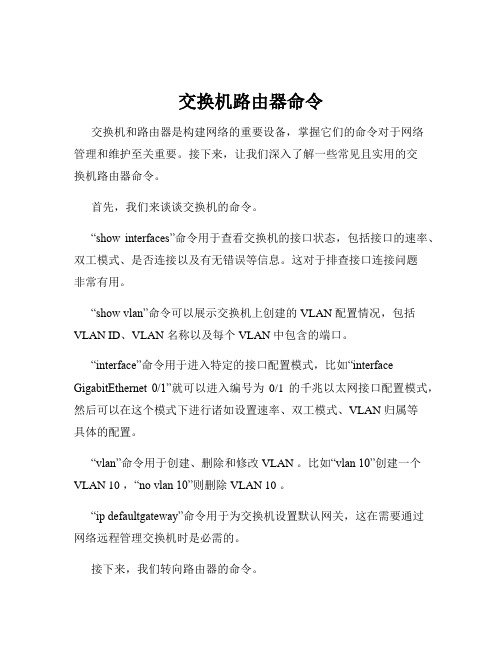
交换机路由器命令交换机和路由器是构建网络的重要设备,掌握它们的命令对于网络管理和维护至关重要。
接下来,让我们深入了解一些常见且实用的交换机路由器命令。
首先,我们来谈谈交换机的命令。
“show interfaces”命令用于查看交换机的接口状态,包括接口的速率、双工模式、是否连接以及有无错误等信息。
这对于排查接口连接问题非常有用。
“show vlan”命令可以展示交换机上创建的 VLAN 配置情况,包括VLAN ID、VLAN 名称以及每个 VLAN 中包含的端口。
“interface”命令用于进入特定的接口配置模式,比如“interface GigabitEthernet 0/1”就可以进入编号为0/1 的千兆以太网接口配置模式,然后可以在这个模式下进行诸如设置速率、双工模式、VLAN 归属等具体的配置。
“vlan”命令用于创建、删除和修改 VLAN 。
比如“vlan 10”创建一个VLAN 10 ,“no vlan 10”则删除 VLAN 10 。
“ip defaultgateway”命令用于为交换机设置默认网关,这在需要通过网络远程管理交换机时是必需的。
接下来,我们转向路由器的命令。
“show ip interface brief”能快速查看路由器接口的 IP 地址配置以及接口的状态,是了解路由器网络连接的重要命令。
“show ip route”命令用于查看路由器的路由表,从中可以知道路由器如何转发数据包到不同的网络。
“router ospf”命令用于启动 OSPF 路由协议,并进入 OSPF 配置模式,然后可以在其中设置区域、宣告网络等参数。
“ip route”命令用于手动添加静态路由,比如“ip route 19216820 2552552550 10002”表示将目标网络 19216820/24 的数据包通过下一跳10002 进行转发。
“accesslist”命令用于创建访问控制列表(ACL),以控制网络流量的访问权限。
路由器和交换机命令大全

路由器和交换机命令大全不论是路由器也好,还是交换机也好,终归都是要依靠命令进行设备控制,因此你是否知道全部的命令呢?何不抓紧时间补全自己所缺失的命令,以便更好的进行工作开展。
「基础配置」进入console口进行本地配置用户模式xx>enable n特权模式xx#configure terminal全局配置模式 xx(config)#interface [f|s] n/m 进入接口配置模式xx(config-if)#进入(子)接口模式后配置IP(config-if)#ip addr A.B.C.D 子网掩码激活接口(config-if)#no shutdown配置速度(config-if)#speed {auto|10|100}配置接口工作模式(config-if)#duplex {auto|half|full}配置时钟(串行口DCE端)(config-if)#clock rate n反向操作(删除配置)no + 命令在换回接口上配多个ip(config-if)#ip addr A.B.C.D 子网掩码(config-if)#ip addr A.B.C.D 子网掩码 secondary查看所有配置#show running-config路由器关闭路由功能充当主机(config)#no ip routing为路由器设置网关(config)#ip default-gateway ip地址改机器名字(config)#hostname yy控制线路超时(config)#line n(config-line)#exec-timeout 0 0关闭域名解析功能(config)#no ip domain-lookup开启路由器http功能(config)#ip http server(config)#username xxx password yyy(config)#username xxx secret yyy(config)#enable secret yyy启用密码加密服务(config)#service password-encryption yyy开启路由器https功能(config)#ip http secure-server开启路由器远程登录功能(config)#line vty 0 4(config)#login local或者(config)#no login(config)#enable n登录时使用命令 telnet A.B.C.D「交换机」查看mac地址表#show mac-address-table绑定静态mac地址(config)#mac-address-table static H.H.H vlan n interface fx/x #show arp在主机上使用arp -a查看arp信息开启交换机端口安全(防止连接主机恶意发送随机mac填满mac地址表)(conifg)#switchport port-security(conifg)#switchport ?#show port-security int fx/x恢复(config)#errdisable recovery 为交换机vlan1配置管理ip(conifg)#int vlan 1(config-if)#ip addr A.B.C.D 子网掩码(config-if)#no shut「交换机vlan」查看vlan #show vlan-switch或是#show vlan创建vlan #vlan database(vlan)#vlan n将端口加入到vlan中(config-if)#switchport access vlan n给允许多个vlan的接口打trunk(config-if)#switchport mode trunk「单臂路由vlan」路由器上配置子接口实现不同vlan之间通信,先必须激活其父接口,另外IP不允许重复(config)#interface fx/x.x(config-subif)#encapsulation dot1q vlan-id(config-subif)#ip addr A.C.D.E 子网掩码(config-subif)#no shut「使用三层交换机交换虚拟接口」交换机上配置虚拟交换接口实现不同vlan之间通信,先必须在交换机上添加对应vlan(config)#int vlan n(config-if)#ip addr A.B.C.D 子网掩码(config-if)#no shut在删除时,务必先删除交换虚拟接口,再删对应vlan「VTP」配置VTP模式#vlan database(vlan)#vtp {server|client|transparent}只有域名和密码完全一样的路由器之间才能同步vlan信息(vlan)#vtp domain <域名>(vlan)#vtp password <密码>打开VTP裁剪(vlan)#vtp pruning退出激活(vlan)#exit 「端口聚合」创建R1(config)#interface port-channel 1(config-if)#switchport trunk encapsulation dot1q(config-if)#switchportmode trunk将指定接口加入聚合组内#int range f x/x-x #channel-group 1 mode on查看聚合接口#show etherchannel summary 「生成树协议」基于vlan的生成树可防止环路开启生成树协议(STP默认是开启的,可省略)(config)#spanning-tree vlan n修改生成树协议优先级(根网桥:mac最小、优先级最小)(config)#spanning-tree vlan n priority m交换机和主机之间连接的端口开启portfast,可防止主机发送BPDU伪造数据(config-if)#spanning-tree portfast查看生成树#show spanning-tree [vlan n]「静态路由」查看协议#show ip protocols查看路由表#show ip route添加静态路由(以默认路由举例)(config)#ip route 0.0.0.0 0.0.0.0 {出接口|下一跳ip}浮动静态路由(备份链路,在原链路失效后起作用)(config)#ip route 0.0.0.0 0.0.0.0 出接口AD管理距离静态黑洞路由(config)#ip route 192.168.0.0 255.255.0.0 null 0「RIP距离矢量路由,动态路由」配置RIP宣告直连网段(config)#router rip(config-router)#network 网段更改为版本2(config-router)#version {2|1}关闭自动汇总(如果被其他网路隔开时,最好关闭自动汇总)(config-router)#no auto-summary设置被动接口(只接受更新,不宣告自己)(config-router)#passive-interface 接口单播更新(只和指定的ip 交换路由信息)(config-router)#neighbor ip地址清除路由表内容#clear ip route *「OSPF链路状态路由,动态路由」配置OSPF宣告直连网路(config)#router ospf <进程号>(config-router)#router-id <任意ip地址>(config-router)#network <反掩码> area n重启OSPF进程#clear ip ospf process查看接口的OSPF信息#show ip ospf interface查看邻居表#show ip ospf neighbor查看链路数据表#show ip ospf database 「EIGRP链路状态路由,动态路由」配置EIGRP宣告直连网路(config)#router eigrp <系统编号>(config-router)#network 查看邻居表#show ip eigrp neighbors 查看拓扑表#show ip eigrp topology「VRRP虚拟路由器路由协议」提供网关冗余查看VRRP信息#show vrrp VRRP配置(在提供备份的两台路由器上做以下配置)端口跟踪(监视某个接口的状态)(config)#track 1 interface 接口line-protocol(config-if)#vrrp <1~254> ip 额外配置优先级(IP和优先级越大Master)和抢占(config-if)#vrrp <1~254> priority <1~254>(config-if)#vrrp <1~254> preempt(config-if)#vrrp 1 track 1 decrement <1~255> 「访问控制列表ACL」ACL无法控制自身发起的流量,对于已经建立的流量不起作用标准ACL(不能单独删除、添加一条访问列表)(config)#access-list <1~99|1300~1999> {permit|deny} ip地址反掩码扩展ACL(config)#access-list <100-199> {permit|deny} <协议> <源ip> <反掩码> <源端口> <目标ip> <反掩码> <目标端口>应用到指定ACL到某个接口(config)#int 接口(config-if)#ip access-group <1~99|100-199|1300~1999> {in|out}命名ACL(config)#ip access-list standard <标准ACL名字>(config-std-nacl)#{permit|deny} ip地址反掩码(config)#ip access-list extended <扩展ACL名字>(config-ext-nacl)#{permit|deny} <协议> <源ip> <反掩码> <源端口> <目标ip> <反掩码> <目标端口>应用到指定ACL到某个接口(config)#int 接口(config-if)#ip access-group <标准ACL名字|扩展ACL名字> {in|out}自反ACL(RACL,可以只允许内网主动发起的流量通过)(config)#ip access-list extended OUTB(config-ext-nacl)#permit tcp any any reflect RACL(config)#ip access-list extended INB(config-ext-nacl)#evaluate RACL(config-ext-nacl)#deny ip any any应用到指定ACL到某个接口(config-if)#ip access-group OUTB out(config-if)#ip access-group INB in 基于时间的ACL设置时区时间(config)#clock timezone GMT +8 #clock set hh:mm:ss <日> <月> <年>定义时间(config)#time-range <时间名>(config-time-range)#periodic hh:mm to hh:mm(config-time-range)#absolute start hh:mm:ss <日> <月> <年> end hh:mm:ss <日> <月> <年>结合ACL(config)#ip access-list extended <扩展ACL名字>(config-ext-nacl)#deny tcp any any time-range <时间名>「NAT和PAT」定义内外网接口(config)#int 接口(config-if)#ip nat {inside|outside}静态NAT(config)#ip nat inside source static ip地址静态PAT(config)#ip nat inside source static <协议> ip地址 <端口号>使用ACL捕获流量(config)#access-list n permit ip地址反掩码(config)#ip nat pool <地址池名> <起始ip地址> <终止ip地址> netmask 掩码TCP负载均衡(轮询转换)(config)#ip nat pool <地址池名> <起始ip地址> <终止ip地址> netmask 掩码type rotary动态NAT(config)#ip nat inside source list n pool <地址池名>动态PAT(config)#ip nat inside source list n pool <地址池名> overload查看转换项#show ip nat translations「广域网PPP协议」在串行口上的两台路由器都封装ppp协议(config)#int sx/x(config-if)#encapsulation ppp(config-if)#no shut 启用PAP认证,未加密认证方(config)#username <用户名>password <密码>(config-if)#ppp authentication pap请求认证方(config-if)#ppp pap sent-username <用户名> password <密码> 启用CHAP认证,安全加密认证方(config)#username <请求认证方名> password <请求认证方密码>(config-if)#ppp authentication chap请求认证方(config)#username <认证方名> password <认证方密码>(config-if)#ppp authentication chap 「帧中继」无广播的多路访问网络(NBMA)配置帧中继交换机关闭路由器路由功能(config)#no ip routing启用帧中继(config)#frame-relay switching进入串行接口R8(config)#int sx/x封装frame-relay协议R8(config-if)#encapsulation frame-relay指定lmi-type类型(config-if)#frame-relay lmi-type cisco指定intf-type接口类型为DCE(config-if)#frame-relay intf-type dce配置时钟频率(config-if)#clock rate n配置DLCI(config-if)#frame-relay route <进DLCI 号> int <出接口> <出DLCI号>配置路由器,封装frame-relay协议(config-if)#encapsulation frame-relay静态指定映射(config-if)#frame-relay map ip 清除动态学到的Frame Relay #clear frame-relay-inarp查看映射#show frame-relay map调试#debug frame-relay lmi点到多点(解决水平分割问题,划分子接口)适用于全互联和部分互联(config)#int sx/x(config-if)#encapsulation frame-relay(config)#int sx/x.x multipoint关闭反向arp,禁止自学习DLCI号和IP对应,而采取静态Map(config-subif)#no frame-relay inverse-arp静态映射DLCI号和IP(config-subif)#frame-relay map ip broadcast如在R1上对R3 DLCI号103 IP地址192.168.1.3点到点子接口(不存在水平分割问题)子接口可以看作是专线,适用于星型(config)#int sx/x(config-if)#encapsulation frame-relay(config)#int sx/x.x point-to-point(config-subif)#frame-relay interface-dlci以上就是店铺带给大家不一样的精彩。
交换机路由器命令
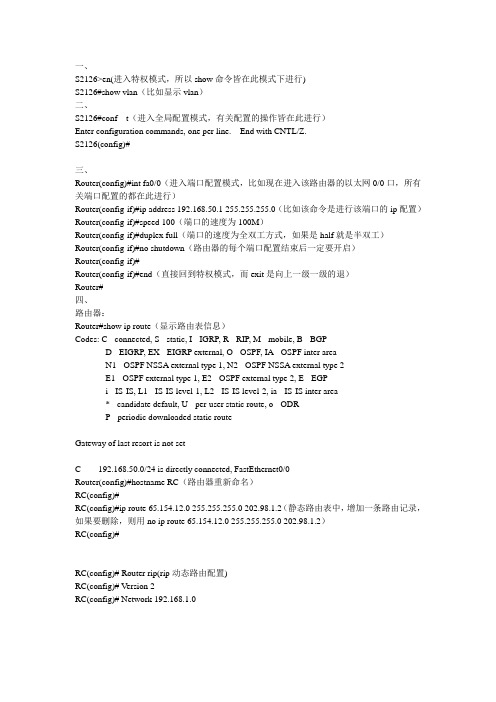
交换机之间trunk
s3550(config-if)#switchport trunk encapsulation dot1q(三层)
s3550(config-if)#switchport mode trunk
S2126(config-if)#switchport mode trunk(二层交换机直接)
Router(config-if)#end(直接回到特权模式,而exit是向上一级一级的退)
Router#
四、
路由器:
Router#show ip route(显示路由表信息)
Codes: C - connected, S - static, I - IGRP, R - RIP, M - mobile, B - BGP
s2126(config-vlan)#exit
s2126(config)#exit
s2126#
s2126#show vlan
VLAN Name Status Ports
---- -------------------------------- --------- -------------------------------
Gateway of last resort is not set
C 192.168.50.0/24 is directly connected, FastEthernet0/0
Router(config)#hostname RC(路由器重新命名)
RC(config)#
RC(config)#ip route 65.154.12.0 255.255.255.0 202.98.1.2(静态路由表中,增加一条路由记录,如果要删除,则用no ip route65.154.12.0 255.255.255.0 202.98.1.2)
交换机路由器命令大全(结合配置实例)
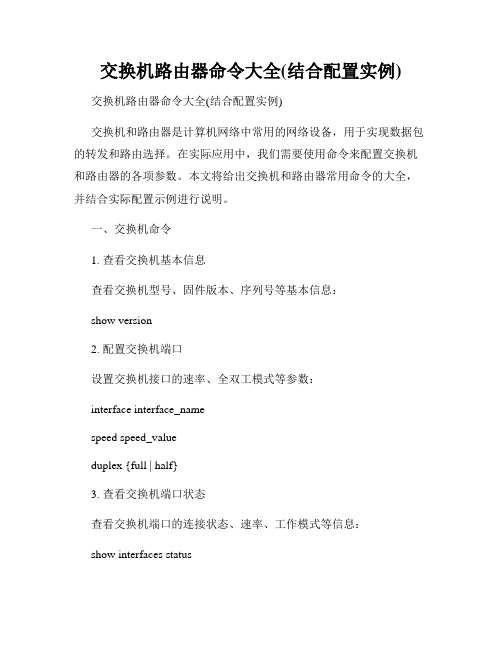
交换机路由器命令大全(结合配置实例)交换机路由器命令大全(结合配置实例)交换机和路由器是计算机网络中常用的网络设备,用于实现数据包的转发和路由选择。
在实际应用中,我们需要使用命令来配置交换机和路由器的各项参数。
本文将给出交换机和路由器常用命令的大全,并结合实际配置示例进行说明。
一、交换机命令1. 查看交换机基本信息查看交换机型号、固件版本、序列号等基本信息:show version2. 配置交换机端口设置交换机接口的速率、全双工模式等参数:interface interface_namespeed speed_valueduplex {full | half}3. 查看交换机端口状态查看交换机端口的连接状态、速率、工作模式等信息:show interfaces status4. 配置交换机VLAN创建VLAN和端口关联,实现VLAN的隔离和管理:vlan vlan_idname vlan_nameinterface interface_name5. 查看交换机MAC表显示交换机学习到的MAC地址和对应的端口:show mac-address-table6. 配置交换机链路聚合将多个物理端口绑定为一个逻辑端口,提高带宽和冗余性:interface port-channel channel_numberdescription description_textswitchport mode trunk/access7. 交换机Spanning Tree配置配置交换机的Spanning Tree协议参数,避免网络环路:spanning-tree vlan vlan_idpriority priority_value二、路由器命令1. 查看路由表显示路由器的路由表,包括直连路由、静态路由和动态路由表项:show ip route2. 配置静态路由手动配置路由器的静态路由表,指定目的网络和下一跳信息:ip route destination_network subnet_mask next_hop_ip3. 配置路由器接口配置路由器的接口参数,包括IP地址、子网掩码、描述等:interface interface_nameip address ip_address subnet_maskdescription description_text4. 配置路由器OSPF协议配置路由器之间的OSPF动态路由协议,实现网络的动态路由选择:router ospf process_idnetwork network_address wildcard_mask area area_number5. 配置路由器ACL配置路由器的访问控制列表,用于控制数据包的流量:access-list access_list_number permit/deny source destination6. 配置路由器NAT配置路由器的网络地址转换功能,实现内网与外网的互通:interface interface_nameip nat inside/outside三、配置实例1. 配置交换机端口接口GigabitEthernet0/1配置为100Mbps全双工模式:interface GigabitEthernet0/1speed 100duplex full2. 配置交换机VLAN创建VLAN10,将接口GigabitEthernet0/1划分到VLAN10:vlan 10name VLAN10interface GigabitEthernet0/13. 配置路由器接口将接口GigabitEthernet0/0配置为192.168.1.1/24的IP地址:interface GigabitEthernet0/0ip address 192.168.1.1 255.255.255.0description LAN interface4. 配置静态路由配置路由器的静态路由表,将目的网络192.168.2.0/24指向下一跳192.168.1.2:ip route 192.168.2.0 255.255.255.0 192.168.1.25. 配置路由器ACL设置访问控制列表,允许源IP地址为192.168.1.0/24的流量通过:access-list 1 permit 192.168.1.0 0.0.0.2556. 配置路由器NAT设置路由器的NAT,将内部接口GigabitEthernet0/1地址转换为公网地址:interface GigabitEthernet0/1ip nat inside以上是交换机和路由器常用命令的大全以及配置实例。
交换机路由器命令大全(结合配置实例)
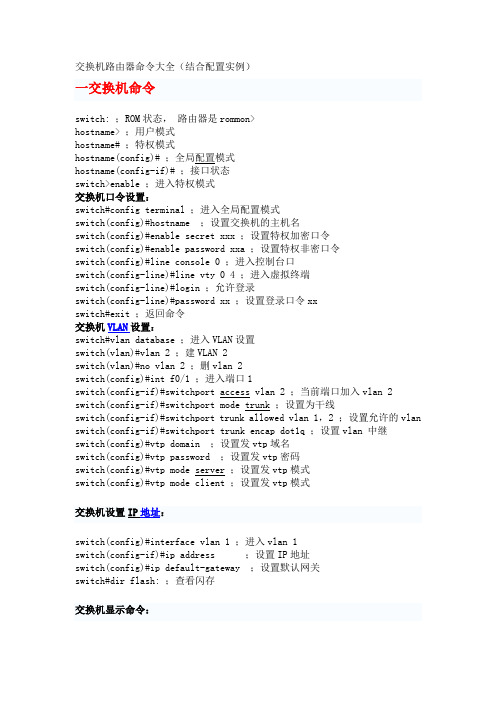
交换机路由器命令大全(结合配置实例)一交换机命令switch: ;ROM状态,路由器是rommon>hostname> ;用户模式hostname# ;特权模式hostname(config)# ;全局配置模式hostname(config-if)# ;接口状态switch>enable ;进入特权模式交换机口令设置:switch#config terminal ;进入全局配置模式switch(config)#hostname ;设置交换机的主机名switch(config)#enable secret xxx ;设置特权加密口令switch(config)#enable password xxa ;设置特权非密口令switch(config)#line console 0 ;进入控制台口switch(config-line)#line vty 0 4 ;进入虚拟终端switch(config-line)#login ;允许登录switch(config-line)#password xx ;设置登录口令xxswitch#exit ;返回命令交换机VLAN设置:switch#vlan database ;进入VLAN设置switch(vlan)#vlan 2 ;建VLAN 2switch(vlan)#no vlan 2 ;删vlan 2switch(config)#int f0/1 ;进入端口1switch(config-if)#switchport access vlan 2 ;当前端口加入vlan 2 switch(config-if)#switchport mode trunk ;设置为干线switch(config-if)#switchport trunk allowed vlan 1,2 ;设置允许的vlan switch(config-if)#switchport trunk encap dot1q ;设置vlan 中继switch(config)#vtp domain ;设置发vtp域名switch(config)#vtp password ;设置发vtp密码switch(config)#vtp mode server ;设置发vtp模式switch(config)#vtp mode client ;设置发vtp模式switch(config)#interface vlan 1 ;进入vlan 1switch(config-if)#ip address ;设置IP地址switch(config)#ip default-gateway ;设置默认网关switch#dir flash: ;查看闪存交换机显示命令:switch#write ;保存配置信息switch#show vtp ;查看vtp配置信息switch#show run ;查看当前配置信息switch#show vlan ;查看vlan配置信息switch#show interface ;查看端口信息switch#show int f0/0 ;查看指定端口信息二、路由器命令路由器显示命令:router#show run ;显示配置信息router#show interface ;显示接口信息router#show ip route ;显示路由信息router#show cdp nei ;显示邻居信息router#reload ;重新起动路由器口令设置:router>enable ;进入特权模式router#config terminal ;进入全局配置模式router(config)#hostname ;设置交换机的主机名router(config)#enable secret xxx ;设置特权加密口令router(config)#enable password xxb ;设置特权非密口令router(config)#line console 0 ;进入控制台口router(config-line)#line vty 0 4 ;进入虚拟终端router(config-line)#login ;要求口令验证router(config-line)#password xx ;设置登录口令xxrouter(config)#(Ctrl+z) ;返回特权模式router#exit ;返回命令路由器配置:router(config)#int s0/0 ;进入Serail接口router(config-if)#no shutdown ;激活当前接口router(config-if)#clock rate 64000 ;设置同步时钟router(config-if)#ip address ;设置IP地址router(config-if)#ip address second ;设置第二个IProuter(config-if)#int f0/0.1 ;进入子接口router(config-subif.1)#ip address ;设置子接口IProuter(config-subif.1)#encapsulation dot1q ;绑定vlan中继协议router(config)#config-register 0x2142 ;跳过配置文件router(config)#config-register 0x2102 ;正常使用配置文件router#reload ;重新引导静态路由:ip route ;命令格式router(config)#ip route 2.0.0.0 255.0.0.0 1.1.1.2 ;静态路由举例router(config)#ip route 0.0.0.0 0.0.0.0 1.1.1.2 ;默认路由举例动态路由:router(config)#ip routing ;启动路由转发router(config)#router rip;启动RIP路由协议。
交换机路由器的基本命令

交换机和路由器是网络中的关键设备,它们有不同的功能和配置命令。
下面是一些基本的命令,用于配置和管理交换机和路由器:### 交换机基本命令:1. 进入特权模式:```enable```2. 进入全局配置模式:```configure terminal```3. 为接口配置VLAN:```interface FastEthernet0/1switchport mode accessswitchport access vlan 10```4. 显示交换机端口状态:```show interfaces status```5. 为交换机配置IP地址:```interface Vlan1ip address 192.168.1.1 255.255.255.0 ```6. 保存配置:```copy running-config startup-config ```### 路由器基本命令:1. 进入特权模式:```enable```2. 进入全局配置模式:```configure terminal```3. 为接口配置IP地址:```interface GigabitEthernet0/0ip address 192.168.1.1 255.255.255.0 ```4. 启用路由协议(如静态路由):```ip route 0.0.0.0 0.0.0.0 192.168.1.254 ```5. 查看路由表:```show ip route```6. 保存配置:```copy running-config startup-config```这些只是基本命令,实际的配置和管理可能会更加复杂,取决于网络需求和设备型号。
在实际应用中,您可能需要查阅特定设备的文档以获取更详细的命令和配置指南。
交换机路由器命令

交换机路由器命令1、系统配置命令1.1 基本配置命令- 设定主机名称命令:hostname [名称]- 设定启动文件位置命令:boot system [文件名]1.2 接口配置命令- 进入接口配置模式命令:interface [接口编号]- 设定IP地质命令:ip address [IP地质]1.3 路由配置命令- 设定默认路由命令:ip route 0:0:0:0 0:0:0:0 [下一跳IP地质]- 设置静态路由命令:ip route [目的网络地质] [目的子网掩码] [下一跳IP地质]1.4 网络服务设置命令- 设置DNS服务器命令:ip name-server [DNS服务器IP地质]2、VLAN配置命令2.1 创建VLAN命令- 进入全局配置模式命令:vlan database- 创建VLAN命令:vlan [VLAN编号]2.2 接口VLAN设置命令- 进入接口VLAN模式命令:interface vlan [VLAN编号]- 设定IP地质命令:ip address [IP地质]3、交换机配置命令3.1 端口设置命令- 进入端口配置模式命令:interface [端口编号]- 设置接口类型命令:switchport mode [access/trunk] - 设置接口所属VLAN命令:switchport access vlan [VLAN编号]3.2 链路聚合命令- 创建聚合组命令:interface port-channel [组号]- 将端口加入聚合组命令:channel-group [组号] mode [active/passive]3.3 STP配置命令- 进入全局配置模式命令:spanning-tree mode [STP 模式]- 设定优先级命令:spanning-tree priority [优先级]4、路由器配置命令4.1 接口配置命令- 进入接口配置模式命令:interface [接口编号]- 设定IP地质命令:ip address [IP地质]4.2 OSPF配置命令- 进入全局配置模式命令:router ospf [进程ID]- 添加网络命令:network [网络地质] [反掩码] area [区域ID]附件:1、附件1:交换机路由器配置示例文件法律名词及注释:- IP地质:Internet Protocol Address,互联网协议地质,用于标识网络中的设备的唯一地质。
交换机和路由器的基本配置命令
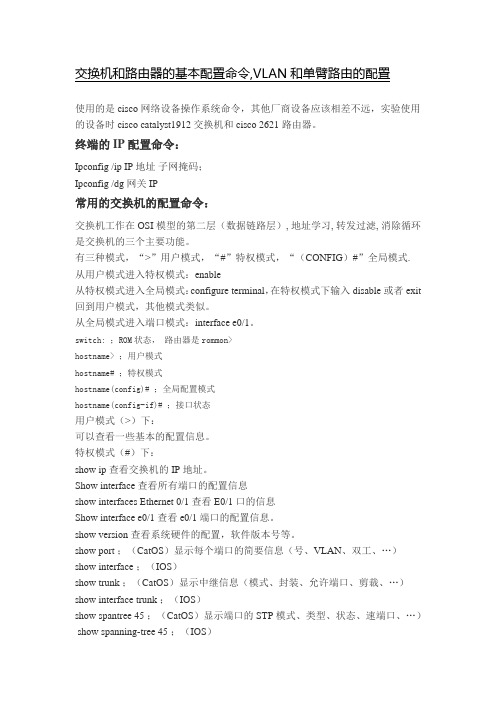
使用的是cisco网络设备操作系统命令,其他厂商设备应该相差不远,实验使用的设备时cisco catalyst1912交换机和cisco 2621路由器。
终端的IP配置命令:Ipconfig /ip IP地址子网掩码;Ipconfig /dg 网关IP常用的交换机的配置命令:交换机工作在OSI 模型的第二层(数据链路层), 地址学习, 转发过滤, 消除循环是交换机的三个主要功能。
有三种模式,“>”用户模式,“#”特权模式,“(CONFIG)#”全局模式.从用户模式进入特权模式:enable从特权模式进入全局模式:configure terminal,在特权模式下输入disable或者exit 回到用户模式,其他模式类似。
从全局模式进入端口模式:interface e0/1。
switch: ;ROM状态,路由器是rommon>hostname> ;用户模式hostname# ;特权模式hostname(config)# ;全局配置模式hostname(config-if)# ;接口状态用户模式(>)下:可以查看一些基本的配置信息。
特权模式(#)下:show ip 查看交换机的IP地址。
Show interface 查看所有端口的配置信息show interfaces Ethernet 0/1 查看E0/1口的信息Show interface e0/1 查看e0/1端口的配置信息。
show version 查看系统硬件的配置,软件版本号等。
show port ;(CatOS)显示每个端口的简要信息(号、VLAN、双工、…)show interface ;(IOS)show trunk ;(CatOS)显示中继信息(模式、封装、允许端口、剪裁、…)show interface trunk ;(IOS)show spantree 45 ;(CatOS)显示端口的STP模式、类型、状态、速端口、…) show spanning-tree 45 ;(IOS)Show running-config (show running也可以)查看当前正在运行的配置信息全局模式//配置模式((config)#):设置交换机名:hostname[交换机名]如:hostname switch1设置交换机的IP地址:ip address [ip address ][netmask]如ip address 172.16.0.1 255.255.0.0设置交换机的缺省网关:ip default-gatway [ip address]如:ip default-gatway 172.16.0.1设置密码enable password level [1-15] [passwork]1-15 表示级别,1表示设置登录时的密码,15设置进入全局模式的密码。
交换机路由器配置基本命令

在全局配置模式中创建VLAN,如下:
S1(config)#vlan 2
S1(config-vlan)#name VLAN2
S1(config-vlan)#exit
S1(config)#vlan 3
S1(config-vlan)#name VLAN3
(2)步骤2:把端口划分在VLAN 中
S1(config)#interface f0/2
S1(config-if)#switch mode access
S1(config-if)#switch access vlan 3
【提示】默认时,所有交换机接口都在VLAN 1 上, 1 是不能删除的。如果有多个接口
需要划分到同一VLAN 下,也可以采用如下方式以节约时间,注意破折号前后的空格:
S1(config)#interface f0/1
S1(config-if)#switch mode access
//以上把交换机端口的模式改为access 模式,说明该端口是用于连接计算机的,而不是用
于trunk
S1(config-if)#switch access vlan 2
//然后把该端口f0/1 划分到VLAN 2 中
S1(config)#interface range f0/2 -3
S1(config-if)#switch mode access
S1(config-if)#switch access vlan 2
【提示】如果要删除VLAN,使用 “no vlan 2”命令即可。删除某一VLAN后,要记得把该VLAN
上的端口重新划分到别的VLAN上,否则将导致端口的“消失”。
路由器和交换机命令大全
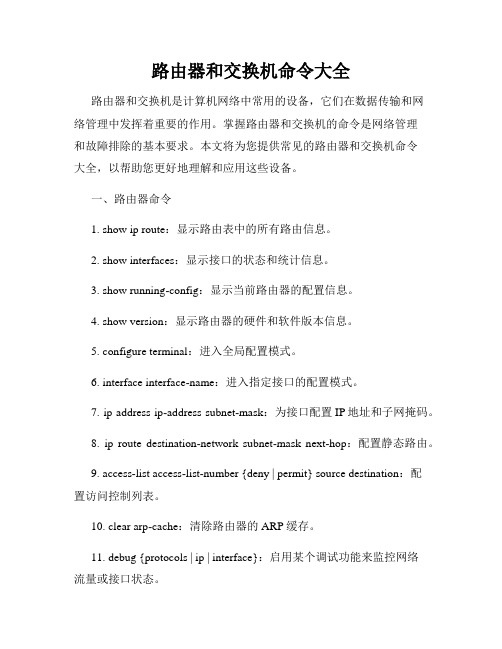
路由器和交换机命令大全路由器和交换机是计算机网络中常用的设备,它们在数据传输和网络管理中发挥着重要的作用。
掌握路由器和交换机的命令是网络管理和故障排除的基本要求。
本文将为您提供常见的路由器和交换机命令大全,以帮助您更好地理解和应用这些设备。
一、路由器命令1. show ip route:显示路由表中的所有路由信息。
2. show interfaces:显示接口的状态和统计信息。
3. show running-config:显示当前路由器的配置信息。
4. show version:显示路由器的硬件和软件版本信息。
5. configure terminal:进入全局配置模式。
6. interface interface-name:进入指定接口的配置模式。
7. ip address ip-address subnet-mask:为接口配置IP地址和子网掩码。
8. ip route destination-network subnet-mask next-hop:配置静态路由。
9. access-list access-list-number {deny | permit} source destination:配置访问控制列表。
10. clear arp-cache:清除路由器的ARP缓存。
11. debug {protocols | ip | interface}:启用某个调试功能来监控网络流量或接口状态。
二、交换机命令1. show interfaces:显示接口的状态和统计信息。
2. show mac-address-table:显示交换机的MAC地址表。
3. show running-config:显示当前交换机的配置信息。
4. show vlan:显示交换机的VLAN信息。
5. configure terminal:进入全局配置模式。
6. interface interface-name:进入指定接口的配置模式。
路由器基本配置命令

15:配置串口参数
两台路由器通过串口连接需要一个做为DTE,一个做为DCE。DCE设备要向DTE设备提供时钟频率和带宽。
DCE配置:
router>en
router #configure terminal
router (conf)#hostname routerA
routerA (conf-line)#login
routerA (conf-line)#password edge 以edge为远程登录的用户密码
主机设置:
ip 192.168.1.2 主机的ip必须和交换机端口的地址在同一网络段
netmask 255.255.255.0
router (conf)#hostname routerA
routerA (conf)#enable password cisco 以cisco为特权模式密码
routerA (conf)#interface fastethernet 0/1 以17端口为telnet远程登录端口
router>enable
router#copy startup-config running-config
router#configure terminal
router(conf)#enable password cisco
router(conf)#config-register 0x2102
router > enable
router #configure terminal
router(conf)#hostname routerA
routerA (conf)# enable password cisco
H3C交换机、路由器常用配置命令大全

H3C交流机设置装备摆设敕令大全【2 】1.system-view 进入体系视图模式2.sysname 为装备定名3.display current-configuration 当前设置装备摆设情形4. language-mode Chinese|English 中英文切换5.interface Ethernet 1/0/1 进入以太网端口视图6. port link-type Access|Trunk|Hybrid 设置端口拜访模式7. undo shutdown 打开以太网端口8. shutdown 封闭以太网端口9. quit 退出当前视图模式10. vlan 10 创建VLAN 10并进入VLAN 10的视图模式11. port access vlan 10 在端口模式下将当前端口参加到vlan 10中12.port E1/0/2 to E1/0/5 在VLAN模式下将指定端口参加到当前vlan中13.port trunk permit vlan all 许可所有的vlan经由过程H3C路由器1.system-view 进入体系视图模式2.sysname R1 为装备定名为R13.display ip routing-table 显示当前路由表4. language-mode Chinese|English 中英文切换5.interface Ethernet 0/0 进入以太网端口视图6. ip address 192.168.1.1 255.255.255.0 设置装备摆设IP地址和子网掩码7. undo shutdown 打开以太网端口8. shutdown 封闭以太网端口9. quit 退出当前视图模式10. ip route-static 192.168.2.0 255.255.255.0 192.168.12.2 description To.R2 设置装备摆设静态路由11. ip route-static 0.0.0.0 0.0.0.0 192.168.12.2 description To.R2 设置装备摆设默认的路由H3C S3100 SwitchH3C S3600 SwitchH3C MSR 20-20 Router############################################################################### ###########1.调剂超级终端的显示字号;2.捕获超级终端操作敕令行,以备日后查对;3. language-mode Chinese|English 中英文切换;4.复制敕令到超级终端敕令行,粘贴到主机;5.交流机消除设置装备摆设 :<H3C>reset save ;<H3C>reboot ;6.路由器.交流机设置装备摆设时不能失落电,连通测试前必定要检讨收集的连通性,不要犯最低级的错误.7.192.168.1.1/24 等同192.168.1.1 255.255.255.0;在设置装备摆设交流机和路由器时, 192.168.1.1 255.255.255.0 可以写成:192.168.1.1 248.装备定名规矩:地名-装备名-系列号例:PingGu-R-S3600###########################################################################H3C华为交流机端口绑定根本设置装备摆设2008-01-22 13:401,端口 MACa)AM敕令应用特别的AM User-bind敕令,来完成MAC地址与端口之间的绑定.例如:[SwitchA]am user-bind mac-address 00e0-fc22-f8d3 interface Ethernet 0/1设置装备摆设解释:因为应用了端口参数,则会以端口为参照物,即此时端口E0/1只许可PC1上彀,而应用其他未绑定的MAC地址的PC机则无法上彀.但是PC1应用该MAC地址可以在其他端口上彀.b)mac-address敕令应用mac-address static敕令,来完成MAC地址与端口之间的绑定.例如:[SwitchA]mac-address static 00e0-fc22-f8d3 interface Ethernet 0/1 vlan 1[SwitchA]mac-address max-mac-count 0设置装备摆设解释:因为应用了端口进修功效,故静态绑定mac后,需再设置该端口mac进修数为0,使其他PC接入此端口后其mac地址无法被进修.2,IP MACa)AM敕令应用特别的AM User-bind敕令,来完成IP地址与MAC地址之间的绑定.例如:[SwitchA]am user-bind ip-address 10.1.1.2 mac-address 00e0-fc22-f8d3设置装备摆设解释:以上设置装备摆设完成对PC机的IP地址和MAC地址的全局绑定,即与绑定的IP地址或者MAC地址不同的PC机,在任何端口都无法上彀.支撑型号:S3026E/EF/C/G/T.S3026C-PWR.E026/E026T.S3050C.E050.S3526E/C/EF.S5012T/G.S5024Gb)arp敕令应用特别的arp static敕令,来完成IP地址与MAC地址之间的绑定.例如:[SwitchA]arp static 10.1.1.2 00e0-fc22-f8d3设置装备摆设解释:以上设置装备摆设完成对PC机的IP地址和MAC地址的全局绑定. 3,端口 IP MAC应用特别的AM User-bind敕令,来完成IP.MAC地址与端口之间的绑定.例如:[SwitchA]am user-bind ip-address 10.1.1.2 mac-address 00e0-fc22-f8d3 interface Ethernet 0/1设置装备摆设解释:可以完成将PC1的IP地址.MAC地址与端口E0/1之间的绑定功效.因为应用了端口参数,则会以端口为参照物,即此时端口E0/1只允许PC1上彀,而应用其他未绑定的IP地址.MAC地址的PC机则无法上彀.但是PC1应用该IP 地址和MAC地址可以在其他端口上彀.###############################################################[S2016-E1-Ethernet0/1]mac-address max-mac-count 0;进入到端口,用敕令mac max-mac-count 0(端口mac进修数设为0)[S2016-E1]mac static 0000-9999-8888 int e0/1 vlan 10;将0000-9999-8888绑定到e0/1端口上,此时只有绑定mac的pc可以经由过程此口上彀,同时E0/1属于vlan 10就如许,ok了,不过上面两个敕令次序不能弄反,除非端口下没有接pc#################################################################dis vlan 显示vlanname text 指定当前vlan的名称undo name 撤消[h3c] vlan 2[h3c-vlan2]name test vlandis users 显示用户dis startup 显示启动设置装备摆设文件的信息dis user-interface 显示用户界面的相干信息dis web users 显示web用户的相干信息.header login 设置装备摆设登陆验证是显示信息header shellundo headerlock 锁住当前用户界面acl 拜访掌握列表 acl number inbound/outbound[h3c]user-interface vty 0 4[h3c-vty0-4] acl 2000 inboundshutdown:封闭vlan接口undo shutdown 打开vlan接口封闭vlan1 接口[h3c] interface vlan-interface 1[h3c-vlan-interface] shutdownvlan vlan-id 界说vlanundo valn vlan-iddisplay ip routing-tabledisplay ip routing-table protocol staticdisplay ip routing-table statisticsdisplay ip routing-table verbose 查看路由表的全体具体信息interface vlan-interface vlan-id 进入valnmanagement-vlan vlan-id 界说治理vlan号reset ip routing-table statistics protocol all 消除所有路由协定的路由信息.display garp statistics interface GigabitEthernet 1/0/1 显示以太网端口上的garp统计信息display voice vlan status 查看语音vlan状况[h3c-GigabitEthernet1/0/1] broadcast-suppression 20 许可接收的最大广播流量为该端口授输才能的20%.超出部分丢弃.[h3c-GigabitEthernet1/0/1] broadcast-suppression pps 1000 每秒许可接收的最大广播数据包为1000传输才能的20%.超出部分丢弃.display interface GigabitEthernet1/0/1 查看端口信息display brief interface GigabitEthernet1/0/1 查看端口扼要设置装备摆设信息display loopback-detection 用来测试环路测试是否开启display transceiver-information interface GigabitEthernet1/0/50 显示光口相干信息duplex auto/full/half[h3c]interface GigabitEthernet1/0/1[h3c-GigabitEthernet1/0/1]duplux auto 设置端口双工属性为自协商port link-type access/hybrid/trunk 默以为accessport trunk permit vlan all 将trunk扣参加所有vlan中reset counters interface GigabitEthernet1/0/1 清晰端口的统计信息speed auto 10/100/1000display port-security 查看端口安全设置装备摆设信息am user-bind mac-addr 00e0-fc00-5101 ip-addr 10.153.1.2 interface GigabitEthernet1/0/1 端口ip 绑定display arp 显示arpdisplay am user-bind 显示端口绑定的设置装备摆设信息display mac-address 显示交流机进修到的mac地址display stp 显示生成树状况与统计信息[h3c-GigabitEthernet1/0/1]stp instance 0 cost 200 设置生成树实例0上路径开销为200stp cost 设置当前端口在指定生成树实例上路径开销.instance-id 为0-16 0表cist 取值规模1-200000< h3c> display system-guard ip-record 显示防进击记载信息.system-guard enable 启用体系防进击功效display icmp statistics icmp流量统计display ip socketdisplay ip statisticsdisplay acl allacl number acl-number match-order auto/configacl-number (2000-2999 是根本acl 3000-3999是高等acl为治理员预留的编号)rule deny/permit protocal拜访掌握[h3c] acl number 3000[h3c-acl-adv-3000]rule permit tcp source 129.9.0.0 0.0.255.255 destination 202.38.160.0 0.0.255.255 destination-port eq 80 (界说高等acl 3000,许可129.0.0/16网段的主机向202.38.160/24网段主机拜访端口80)rule permit source 211.100.255.0 0.255.255.255rule deny cos 3 souce 00de-bbef-adse ffff-ffff-fff dest 0011-4301-9912 ffff-ffff-ffff(制止mac地址00de-bbef-adse发送到mac地址0011-4301-9912且802.1p优先级为3的报文经由过程)display qos-interface GigabitEthernet1/0/1 traffic-limit 查看端口上流量端口速度限制line-rate inbound/outbound target-rateinbound:对端口吸收报文进行速度限制outbound: 对端口发送报文进行速度限制target-rate 对报文限制速度,单位kbps 千兆口inbound规模1-1000000 outbound规模20-1000000undo line-rate撤消限速.[h3c]interface GigabitEthernet1/0/1[h3c-GigabitEthernet1/0/1]line-rate outbound 128 限制出去速度为128kbpsdisplay arp | include 77display arp count 盘算arp表的记载数display ndp 显示交流机端口的具体设置装备摆设信息.display ntdp device-list verbose 收集装备具体信息display lockdisplay users display cpu display memory display fan display device display power。
- 1、下载文档前请自行甄别文档内容的完整性,平台不提供额外的编辑、内容补充、找答案等附加服务。
- 2、"仅部分预览"的文档,不可在线预览部分如存在完整性等问题,可反馈申请退款(可完整预览的文档不适用该条件!)。
- 3、如文档侵犯您的权益,请联系客服反馈,我们会尽快为您处理(人工客服工作时间:9:00-18:30)。
准备工作:1)SecureCRT 软件(推荐使用8.0注册机版)2)console线一条,RS232转USB线一条(淘宝购买)RS232转USB线插在电脑上,打开设备管理(快捷键devmgmt.msc),就会有提示,用360驱动(或其他驱动软件)打上即可。
下图为驱动安装成功后的设备管理器界面(本人电脑系统为win10)。
注意:com口与电脑上USB口是对应的,接在另一个USB口,com口的序号会变化。
file:///C:/Users/Potter/AppData/Local/Temp/msohtmlclip1/01/clip_image 002.jpg3)电脑一台4)网络基础知识(OSI,IP,路由交换基础等)5)登陆设备 ( CLI命令行)设备-----Console—RS232-USB---电脑,打开SecureCRT软件file:///C:/Users/Potter/AppData/Local/Temp/msohtmlclip1/01/clip_image 004.jpg一,锐捷交换机 ( 和cisco命令类似)1,设备登陆Web登陆:192.168.1.1admin/adminConsole密码:默认为空,如果不行试试ruijie / admin2,系统基本配置!enable //进入用户模式,华为H3C无对应命令clockset 10:00:00 3 17 2017//clock set 小时:分:秒月日年!config//进入全局模式,对应华为H3C的sys hostname xx //修改设备名称!3,配置vlan!config//进入全局模式vlan 10name xxx//创建一个vlan,并命名vlan 20name xxxexit!no vlan 10 //删除一个vlan!int range gi 0/2-4sw mo ac//配置多个接口为access模式sw ac vl 10//配置多个接口加入vlan10exit!int range gi 0/5-8sw mo tr//配置多个接口为trunk模式sw tr al vl al//配置trunk模式下,接口允许所有vlan(1-4094)通过sw tr na vl 20//配置多个接口为trunk,并指定native vlan为20sw tr al vl remove xx //配置trunk模式下,接口不允许哪些vlan不通过sw tr al vl add xx//配置trunk模式下,接口添加哪些vlan允许通过exit!!sh vlan//查看 vlan 信息,包括 vlan id、名称、状态、包括的接口!sh int gi 0/2 sw//查看接口 Gi 0/2 的 vlan 状态!4,配置接口!configint gi 0/1des xx //给接口配置描述ip add 1.1.1.1 255.255.255.0//路由口配置IP地址,交换口无法直接配置no sh!int vlan 10des xx//给SVI接口配置描述ip add 172.16.10.1 255.255.255.0//创建SVI接口,一般为作为网关或管理地址!注意:SVI接口状态跟是否创建vlan,以及是否存在加入该vlan的up状态的接口。
!!int gi 0/1//以下命令只对路由口和交换口生效speed 10/100/1000//配置接口的速率参数duplex full/half/auto//配置接口的双工模式shut //关闭接口no shut //开启接口!!sh run int gi 0/1//查看接口的配置sh int gi 0/1 //查看接口的详细信息sh int gi 0/1 sta //查看接口状态(up/down)sh int gi 0/48 tra //查看接口的光模块状态(该命令只对光口有效)sh ip int br//查看接口IP地址信息!5,配置聚合(这里只介绍二层聚合)!configint agg 2 //创建一个聚合口2sw mo tr//配置聚合接口为trunk模式sw tr al vl al//配置trunk模式下,聚合接口允许所有vlan(1-4094)通过exit!int range gi 0/1-2port-group 2 //将多个接口加入聚合组2no port-group //退出聚合组exit!sh run int agg 1 //查看聚合口1的配置sh agg 1 sum//查看聚合口1的汇总信息!6,配置DHCP!configvlan80//创建一个vlanname xxexit!interface VLAN 80ip address 192.168.80.1 255.255.255.0//配置DHCP的网关exit!servicedhcp //开启DHCP功能!ip dhcp excluded-address 192.168.80.1 192.168.80.10ip dhcp excluded-address 192.168.80.201 192.168.80.254//配置DHCP不分配的地址!ip dhcp pool vlan80 //创建一个DHCP地址池network 192.168.80.0 255.255.255.0 //配置DHCP地址池的范围dns-server 202.103.24.68 202.103.44.150//配置DNSdefault-router 192.168.80.1//配置网关!sh ip dhcp binding //查看DHCP服务器IP地址分配情况sh ip dhcp conflict//查看DHCP服务器的地址冲突情况sh ip dhcp pool//查看DHCP 地址池的信息sh dhcp lease//查看DHCP租约信息!7,配置路由!configip route 0.0.0.0 0.0.0.0x.x.x.x //配置默认路由ip route 192.168.10.0 255.255.255.0 x.x.x.x//配置静态路由(常用于回程路由)no ip route 192.168.10.0//删除静态路由,不需要写子网掩码!注意:路由的本质是有去有回,路由不通,首先要检查是否有回来的路由。
!sh ip ro //查看路由表sh ip ro sta//查看静态路由(常用于查看设备网关)!8,配置telnet!configline vty 0 4//在控制台0-4 下login//允许登陆password weijishi //登陆时的密码(console线登陆)!enable password xx//用户模式下的密码,>代表特权模式,#代表用户模式!9,配置LLDP (链路层发现协议)!configlldp enable//开启LLDP功能!sh lldp nei//查看LLDP邻居信息!说明:主流路由设备都支持,相当好用的一条命令!!!!通过该命令可以查看本设备的哪个接口接到邻居设备的哪个接口。
对于了解当前网络拓扑起着关键性作用。
(很多中小型企业的网线基本是不打标签的,即使打了也看不懂。
)注意:只能是相同型号的设备互联,才能查看到信息。
比如锐捷交换机---华为交换机,就查看不到信息。
10,配置SNMP!configsnmp community ruijie wr//配置读写团体字为ruijiesnmp community ruijie ro//配置读团体字为ruijiesnmp community ruijie wr//配置写团体字为ruijie!sh snmp //查看snmp信息!11,常用维护命令!sh ver//查看软件版本sh ver slo//查看设备的槽位和板卡信息sh manu//查看设备的资产信息sh cpu//查看设备的CPU信息sh mem //查看设备的内存信息sh tem//查看设备的温度信息sh fan//查看设备的风扇信息sh power//查看设备的电源信息sh int sta//查看接口的状态信息sh int tra//查看接口光模块信息sh ip int br //查看接口的IP地址信息sh ip ro sta //查看静态路由sh run//查看当前配置sh run int xxx //查看接口配置sh vlan br//查看vlan信息sh arp//查看arp表sh mac//查看mac地址表sh log//查看系统日志sh clo //查看时钟信息sh date //查看日期信息sh diag//查看诊断信息,时间有点长,注意多等会,一般是给研发看的!二,华为交换机(H3C交换机命令参照华为交换机)1,设备登陆Web登陆:192.168.0.1admin/Admin@123huawei/Admin@huaweiConsole密码:默认为空2,系统基本配置!sys//全称为system-view,对应锐捷思科的config t (全局模式)sysn xx//修改设备名称!3,配置vlan!sysvlan10//创建一个vlanname xx//给vlan命名vlan batch 11 to 1921 to 22 //创建多个连续的和不连续的vlan!int g0/0/1des xxx//配置接口描述po link-t ac//配置接口为access模式po default vlan 10//将接口加入vlan10quit!int g0/0/2des xxx//配置接口描述po link-t tr//配置接口为trunk模式po tr al vl al//配置接口trunk模式下允许所有vlan(1-4094),不敲该命令,默认只允许vlan1po tr al vl 2 to 3 //配置接口trunk模式下仅允许vlan2-3po tr pv vl 10//配置接口trunk模式下pvid vlan(本征vlan)为10,对应锐捷思科的native vlanquit!dis vlan//查看vlan信息!4,配置接口!sysint g0/0/1des xx//给接口配置描述ip add 1.1.1.1 24//路由口配置IP地址,子网掩码可以直接写数字un shquit!vlan 10!int vlan 10des xx//给SVI接口配置描述ip add 172.16.10.1 255.255.255.0//创建SVI接口,一般为作为网关或管理地址shut//关闭接口un sh//开启接口,对应锐捷思科的nosh!int g0/0/1negotiation auto//配置以太网接口工作在自协商模式undo negotiation auto//配置以太网接口工作在强制协商模式(多用于不同厂家设备互联)auto speed 10/100/1000//配置接口速率auto duplex full/half//配置接口双工模式!dis cu int g0/0/1 //查看接口的配置dis int g0/0/1 //查看接口的详细信息dis int des //查看接口描述信息dis int br//查看接口状态和配置的简要信息dis tra int gi 0/48 ver//查看接口的光模块状态(该命令只对光口有效)dis ip int br//查看接口IP地址信息!【COMBO口】复用口,一光口+一电口,不能同时使用,一次只能使用一种。
